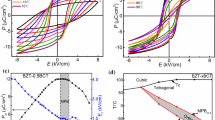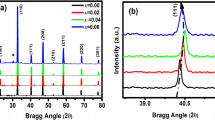Abstract
The solid-state reaction method is used to prepare the 0.94(Bi0.5Na0.5)TiO3–0.06BaTiO3 modified by WO3 lead-free ceramic. The unpoled (Bi0.5Na0.5)0.94Ba0.06Ti1−(3/2)x W x O3 with pseudo-cubic structure undergoes transition from ferroelectric to relaxor ferroelectric that happens in the T d. The maximum reversible temperature change |ΔT| = 0.8 K occurs at the room temperature due to the decline of temperature. In addition, |ΔT| = 0.15 K at the (Bi0.5Na0.5)0.94Ba0.06Ti1−(3/2)x W x O3 with x = 0.75 mol% exhibits good thermal stability at the temperature range of 303–413 K.









Similar content being viewed by others
References
M. Sanlialp, V.V. Shvartsman, M. Acosta, B. Dkhil, D.C. Lupascu, Strong electrocaloric effect in lead-free 0.65Ba(Zr0.2Ti0.8)O3–0.35(Ba0.7Ca0.3)TiO3 ceramics obtained by direct measurements. Appl. Phys. Lett. 106(6), 062901 (2015). doi:10.1063/1.4907774
C. Molin, M. Sanlialp, V.V. Shvartsman et al., Effect of dopants on the electrocaloric effect of 0.92 Pb(Mg1/3Nb2/3)O3–0.08 PbTiO3 ceramics. J. Eur. Ceram. Soc. 35(7), 2065 (2015). doi:10.1016/j.jeurceramsoc.2015.01.016
J. Koruza, B. Rožič, G. Cordoyiannis, B. Malič, Z. Kutnjak, Large electrocaloric effect in lead-free K0.5Na0.5NbO3–SrTiO3 ceramics. Appl. Phys. Lett. 106(20), 202905 (2015). doi:10.1063/1.4921744
P.D. Thacher, Electrocaloric effects in some ferroelectric and antiferroelectric Pb(Zr, Ti)O3 compounds. J. Appl. Phys. 39(4), 1996 (1968). doi:10.1063/1.1656478
Z. Luo, D. Zhang, Y. Liu et al., Enhanced electrocaloric effect in lead-free BaTi1−xSnxO3 ceramics near room temperature. Appl. Phys. Lett. 105(10), 102904 (2014). doi:10.1063/1.4895615
Y. Bai, X. Han, X.C. Zheng, L. Qiao, Both high reliability and giant electrocaloric strength in BaTiO(3) ceramics. Sci. Rep. 3, 2895 (2013). doi:10.1038/srep02895
S. Lisenkov, I. Ponomareva, Giant elastocaloric effect in ferroelectric Ba0.5Sr0.5TiO3 alloys from first-principles. Phys. Rev. B 86(10), 104103 (2012). doi:10.1103/PhysRevB.86.104103
S. Prosandeev, I. Ponomareva, L. Bellaiche, Electrocaloric effect in bulk and low-dimensional ferroelectrics from first principles. Phys. Rev. B 78(5), 052103 (2008). doi:10.1103/PhysRevB.78.052103
M. Valant, L.J. Dunne, A.-K. Axelsson et al., Electrocaloric effect in a ferroelectric Pb(Zn1/3Nb2/3)O3–PbTiO3 single crystal. Phys. Rev. B 81(21), 214110 (2010). doi:10.1103/PhysRevB.81.214110
Z. Zuo, B. Chen, B. Wang et al., Strain assisted electrocaloric effect in PbZr0.95Ti0.05O3 films on 0.7Pb(Mg1/3Nb2/3)O3–0.3PbTiO3 substrate. Sci. Rep. 5, 16164 (2015). doi:10.1038/srep16164
I. Kriaa, N. Abdelmoula, A. Maalej, H. Khemakhem, Study of the electrocaloric effect in the relaxor ferroelectric ceramic 0.75PMN–0.25PT. J. Electron. Mater. 44(12), 4852 (2015). doi:10.1007/s11664-015-4051-7
W. Geng, Y. Liu, X. Meng et al., Giant negative electrocaloric effect in antiferroelectric La-doped Pb(ZrTi)O3 thin films near room temperature. Adv. Mater. 27(20), 3165 (2015). doi:10.1002/adma.201501100
A.S. Qz, F. Mischenko, R.W. Scott, N.D. Whatmore, Mathur, giant electrocaloric effect in thin-film PbZr0.95Ti0.05O3. Science 311, 1270 (2006)
D. Vriami, E. Beaugnon, P. Cool, J. Vleugels, O. Van der Biest, Hydrothermally synthesized BaTiO3 textured in a strong magnetic field. Ceram. Int. 41(4), 5397 (2015). doi:10.1016/j.ceramint.2014.12.104
Q. Xu, T. Li, H. Hao et al., Enhanced energy storage properties of NaNbO3 modified Bi0.5Na0.5TiO3 based ceramics. J. Eur. Ceram. Soc. 35(2), 545 (2015). doi:10.1016/j.jeurceramsoc.2014.09.003
T. Wang, L. Jin, C. Li, Q. Hu, X. Wei, D. Lupascu, Relaxor ferroelectric BaTiO3–Bi(Mg2/3Nb1/3)O3 ceramics for energy storage application. J. Am. Ceram. Soc. 98(2), 559 (2015). doi:10.1111/jace.13325
Y. Liu, J. Wei, P.-E. Janolin, I.C. Infante, X. Lou, B. Dkhil, Giant room-temperature barocaloric effect and pressure-mediated electrocaloric effect in BaTiO3 single crystal. Appl. Phys. Lett. 104(16), 162904 (2014). doi:10.1063/1.4873162
B. Asbani, J.L. Dellis, A. Lahmar et al., Lead-free Ba0.8Ca0.2(ZrxTi1−x)O3 ceramics with large electrocaloric effect. Appl. Phys. Lett. 106(4), 042902 (2015). doi:10.1063/1.4906864
W. Bai, L. Li, W. Wang, B. Shen, J. Zhai, Phase diagram and electrostrictive effect in BNT-based ceramics. Solid State Commun. 206, 22 (2015). doi:10.1016/j.ssc.2015.01.004
J. Rödel, K.G. Webber, R. Dittmer, W. Jo, M. Kimura, D. Damjanovic, Transferring lead-free piezoelectric ceramics into application. J. Eur. Ceram. Soc. 35(6), 1659 (2015). doi:10.1016/j.jeurceramsoc.2014.12.013
Q. Li, J. Wang, H. Fan, Large electrocaloric effect in (Bi0.5Na0.5)0.94Ba0.06TiO3 lead-free ferroelectric ceramics by La2O3 addition. Mater. Res. Bull. 74, 57 (2016). doi:10.1016/j.materresbull.2015.10.010
X. Wang, H. Sun, X. Yao, Effect of WO3 doping on dielectric and ferroelectric properties of 0.94Bi0.5Na0.5TiO3–6BaTiO3 ceramics. Ceram. Int. 38S, S373 (2012). doi:10.1016/j.ceramint.2011.05.015
C. Xu, D. Lin, K.W. Kwok, Structure, electrical properties and depolarization temperature of (Bi0.5Na0.5)TiO3–BaTiO3 lead-free piezoelectric ceramics. Solid State Sci. 10(7), 934 (2008). doi:10.1016/j.solidstatesciences.2007.11.003
G.-P. Zheng, Y. Bai, S.-Q. Shi, Abnormal electrocaloric effect of Na0.5Bi0.5TiO3–BaTiO3 lead-free ferroelectric ceramics above room temperature. Mater. Res. Bull. 46, 1866 (2011). doi:10.1016/j.materresbull.2011.07.038
Y. Bai, G. Zheng, S. Shi, Direct measurement of giant electrocaloric effect in BaTiO3 multilayer thick film structure beyond theoretical prediction. Appl. Phys. Lett. 96(19), 192902 (2010). doi:10.1063/1.3430045
M. Aly, Hamad, detecting giant electrocaloric effect in SrxBa1−xNb2O6 single crystals. Appl. Phys. Lett. 100(19), 192908 (2012). doi:10.1063/1.4718350
T.M. Correia, J.S. Young, R.W. Whatmore, J.F. Scott, N.D. Mathur, Q. Zhang, Investigation of the electrocaloric effect in a PbMg2/3Nb1/3O3–PbTiO3 relaxor thin film. Appl. Phys. Lett. 95(18), 182904 (2009). doi:10.1063/1.3257695
B.C. Bret Neese, S.-G. Lu, Y. Wang, E. Furman, Q.M. Zhang, Large electrocaloric effect in ferroelectric polymers near room temperature. Science 321, 821 (2008)
W. Jo, J. Daniels, D. Damjanovic, W. Kleemann, J. Rödel, Two-stage processes of electrically induced-ferroelectric to relaxor transition in 0.94(Bi1/2Na1/2)TiO3–0.06BaTiO3. Appl. Phys. Lett. 102(19), 192903 (2013). doi:10.1063/1.4805360
J. Yi, L. Zhang, B. Xie, S. Jiang, The influence of temperature induced phase transition on the energy storage density of anti-ferroelectric ceramics. J. Appl. Phys. 118(12), 124107 (2015). doi:10.1063/1.4931886
Q. Li, J. Wang, Z. Liu, G. Dong, H. Fan, Enhanced energy-storage properties of BaZrO3-modified 0.80Bi0.5Na0.5TiO3–0.20Bi0.5K0.5TiO3 lead-free ferroelectric ceramics. J. Mater. Sci. 51(2), 1153 (2016). doi:10.1007/s10853-015-9446-6
Z. Xu, X. Hao, S. An, Dielectric properties and energy-storage performance of (Na0.5Bi0.5)TiO3–SrTiO3 thick films derived from polyvinylpyrrolidone-modified chemical solution. J. Alloys Compd. 639, 387 (2015). doi:10.1016/j.jallcom.2015.03.133
Acknowledgments
This work was supported by the National Nature Science Foundation (51172187), the SPDRF (20116102130002, 20116102120016), the 111 Program (B08040) of MOE, the Xi’an Science and Technology Foundation (XBCL-1-08), the SKLP Foundation (KP201421, KP201523), the Project of Key Areas of Innovation team in Shaanxi Province (No. 2014KCT-12), the Fundamental Research Funds for the Central Universities (3102014JGL01002, 3102014JGY01004), and the Aeronautical Science Foundation of China (2013ZF53072).
Author information
Authors and Affiliations
Corresponding author
Rights and permissions
About this article
Cite this article
Wang, J., Li, Q., Ma, Y. et al. The electrocaloric effect and thermal stability of 0.94(Bi0.5Na0.5)TiO3–0.06BaTiO3 modified by WO3 . Appl. Phys. A 122, 517 (2016). https://doi.org/10.1007/s00339-016-0044-5
Received:
Accepted:
Published:
DOI: https://doi.org/10.1007/s00339-016-0044-5




